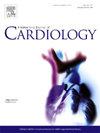Comparison of different guidance strategies to percutaneous coronary intervention: A network meta-analysis of randomized clinical trials
IF 3.2
2区 医学
Q2 CARDIAC & CARDIOVASCULAR SYSTEMS
引用次数: 0
Abstract
Background
The results of randomized clinical trials comparing the outcomes of different strategies for driving PCI are mixed, and it remains unclear which technique for driving PCI offers the greatest benefit. The aim of the study was to compare the clinical efficacy of different techniques to guide percutaneous coronary intervention (PCI).
Methods
We search major electronic databases for randomized clinical trials evaluating clinical outcomes of PCI with stent implantation guided by coronary angiography (CA), fractional flow reserve (FFR), instantaneous wave-free ratio (iFR), intravascular ultrasound (IVUS) and optical coherence tomography (OCT). The primary outcome was cardiac death.
Results
The results from 39 randomized trials (29,614 patients) were included in the network meta-analyses. Compared with CA, the use of OCT (RR: 0.33, 95 % CI: 0.19–0.54), IVUS (RR: 0.47, 95 % CI: 0.31–0.71) and FFR (RR: 0.61, 95 % CI: 0.38–0.97) were associated with reduced risk of cardiac death; there were no differences between OCT, IVUS and OCT was ranked as the best strategy. PCI guidance using OCT, FFR and IVUS was also associated with a reduction of myocardial infarction. The use of OCT or IVUS for PCI guidance was associated with a significant reduction in target lesion failure, target vessel revascularization, target lesion revascularization and stent thrombosis, compared with CA. OCT-guided PCI was associated with a significant reduction in all-cause death compared with CA-guided PCI and with a reduction in TLF compared with FFR- and iFR-guided PCI. Pooled estimates were mostly consistent across several sensitivity analyses.
Conclusions
Compared with angiography-guided PCI, both an intravascular imaging-guided strategy and a physiology-guided strategy are associated with better clinical outcomes.

经皮冠状动脉介入治疗不同指导策略的比较:随机临床试验的网络荟萃分析。
背景:比较不同驱动PCI策略的随机临床试验结果好坏参半,目前尚不清楚哪种驱动PCI技术能提供最大的益处。本研究的目的是比较不同技术指导经皮冠状动脉介入治疗(PCI)的临床疗效。方法:我们检索主要的电子数据库,以随机临床试验评估冠状动脉造影(CA)、血流储备分数(FFR)、瞬时无波比(iFR)、血管内超声(IVUS)和光学相干断层扫描(OCT)引导下PCI支架植入术的临床结果。主要结局为心源性死亡。结果:39项随机试验(29,614例患者)的结果被纳入网络荟萃分析。与CA相比,使用OCT (RR: 0.33, 95 % CI: 0.19-0.54)、IVUS (RR: 0.47, 95 % CI: 0.31-0.71)和FFR (RR: 0.61, 95 % CI: 0.38-0.97)与心脏性死亡风险降低相关;OCT、IVUS之间无差异,OCT被评为最佳策略。使用OCT、FFR和IVUS进行PCI指导也与心肌梗死的减少有关。与CA相比,使用OCT或IVUS进行PCI指导与靶病变失败、靶血管重建术、靶病变重建术和支架血栓形成的显著降低相关。与CA引导的PCI相比,OCT引导的PCI与全因死亡显著降低相关,与FFR和ifr引导的PCI相比,与TLF降低相关。汇总估计在几个敏感性分析中基本一致。结论:与血管造影引导下的PCI相比,血管内成像引导策略和生理引导策略均具有更好的临床效果。
本文章由计算机程序翻译,如有差异,请以英文原文为准。
求助全文
约1分钟内获得全文
求助全文
来源期刊

International journal of cardiology
医学-心血管系统
CiteScore
6.80
自引率
5.70%
发文量
758
审稿时长
44 days
期刊介绍:
The International Journal of Cardiology is devoted to cardiology in the broadest sense. Both basic research and clinical papers can be submitted. The journal serves the interest of both practicing clinicians and researchers.
In addition to original papers, we are launching a range of new manuscript types, including Consensus and Position Papers, Systematic Reviews, Meta-analyses, and Short communications. Case reports are no longer acceptable. Controversial techniques, issues on health policy and social medicine are discussed and serve as useful tools for encouraging debate.
 求助内容:
求助内容: 应助结果提醒方式:
应助结果提醒方式:


